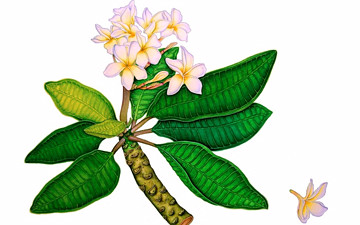Plumeria (common name Frangipani; syn. Himatanthus Willd. ex Roem. & Schult.) is a small genus of 7-8 species native to tropical and subtropical Americas.[2] The genus consists of mainly deciduous shrubs and trees. P. rubra (Common Frangipani, Red Frangipani, Champa), native to Mexico, Central America, Colombia, and Venezuela,[2] produces flowers ranging from yellow to pink . From Mexico and Central America, Plumeria has spread to all tropical areas of the world. [citation needed] In Hawaii, it is grown for the production of leis.[3]
Plumeria is related to the Oleander, Nerium oleander, and both possess poisonous, milky sap, rather similar to that of Euphorbia. Each of the separate species of Plumeria bears differently shaped alternate leaves and their form and growth habits are also distinct. The leaves of P. alba are quite narrow and corrugated, while leaves of P. pudica have an elongated oak shape and glossy, dark green color. P. pudica is one of the everblooming types with non-deciduous, evergreen leaves. Another species that retains leaves and flowers in winter is P. obtusa; though its common name is “Singapore,” it is originally from Colombia. Frangipani can also be found in Eastern Africa, where they are sometimes referred to in Swahili love poems.[4]
Plumeria flowers are most fragrant at night in order to lure sphinx moths to pollinate them. The flowers have no nectar, and simply dupe their pollinators. The moths inadvertently pollinate them by transferring pollen from flower to flower in their fruitless search for nectar. “Plumeria” species may be easily propagated from cuttings of leafless stem tips in spring. Cuttings are allowed to dry at the base before planting in well drained soil. Cuttings are particularly susceptible to rot in moist soil. Propagation can also be by tissue culture from cuttings of freshly elongated stems or aseptically germinated seed. Pruning is best accomplished in the winter for deciduous varieties, or when cuttings are desired.
There are more than 300 named varieties of Plumeria.
(From Wikipedia.org, July 15 2010)
– – –




